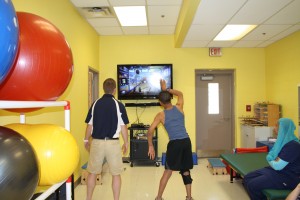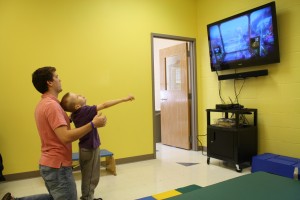May 24, 2012
by: Renee Canfield
Playing Games Isn’t Just for Fun
Last week I had one of those experiences during the day that reminded me why I love working at UCP. After a disappointing morning working on the agency grants plan, I went to Children’s Services to visit with some clients. I was met with several smiles from young clients busy at work around the therapy room. But the most noise was coming from the back room, where I found ten year old Dawud and Therapy Aide, Nick, playing on the Kinect system. Both were laughing as Dawud leaned one direction, then the other; crouched down and then jumped up to avoid a rolling barrel—high fiving Nick when they got to the end. How could anyone having this much fun be doing actual therapy?
 But it was true, the evidence was right before me. Dawud was completely engaged with game, reacting to the stimulus from the screen, balancing back and forth on different legs, bending and jumping. The screen was recording his actions in real time, down to which leg he was putting more weight on and where he was holding his arms. Physical Therapy Assistant Nancy Rodriguez coached Dawud from the sidelines, reminding him to try to place his weight more evenly on both feet and be mindful of his posture to work his core muscles.
But it was true, the evidence was right before me. Dawud was completely engaged with game, reacting to the stimulus from the screen, balancing back and forth on different legs, bending and jumping. The screen was recording his actions in real time, down to which leg he was putting more weight on and where he was holding his arms. Physical Therapy Assistant Nancy Rodriguez coached Dawud from the sidelines, reminding him to try to place his weight more evenly on both feet and be mindful of his posture to work his core muscles.
Interactive gaming technology is being used more and more for rehabilitation and therapeutic purposes. Studies are showing positive findings, especially when used as a tool for increased motivation, interest and perseverance in clients participating in therapy. Use of the Kinect in therapy allows children especially to see the cause and effect of their movements in a fun and visual way. Seeing their movements on the screen in a fun activity also engages them mentally rather than having them go through a mundane, specific set of movements or exercises. They begin to look forward to therapy and can more clearly demonstrate and understand their own advancements and improved abilities. Therapists at UCP have started using the interactive gaming system to facilitate coordination, balance and strength. Clients recognize the natural actions required for the game and that makes it easier for them to participate in the therapy. Games help individuals with cognitive issues by teaching them to follow a sequence of steps, which an essential element of therapy. Parents and caregivers are also able to more clearly see the opportunities for practicing the new skills and movements at home, with or without their own home gaming system.
UCP is very excited about incorporating this gaming technology into our therapy programs. Therapists are already discussing the many ways it can be used to improve outcomes for our young clients, including not only physical therapy applications, but also improving social and peer-to-peer interactions. UCP has been able to purchase two large TVs and kinect gaming systems through the generosity of a grant from Ronald McDonald House Charities of Northeast Ohio and Ronald McDonald House Charities, national offices.

Leave a Reply